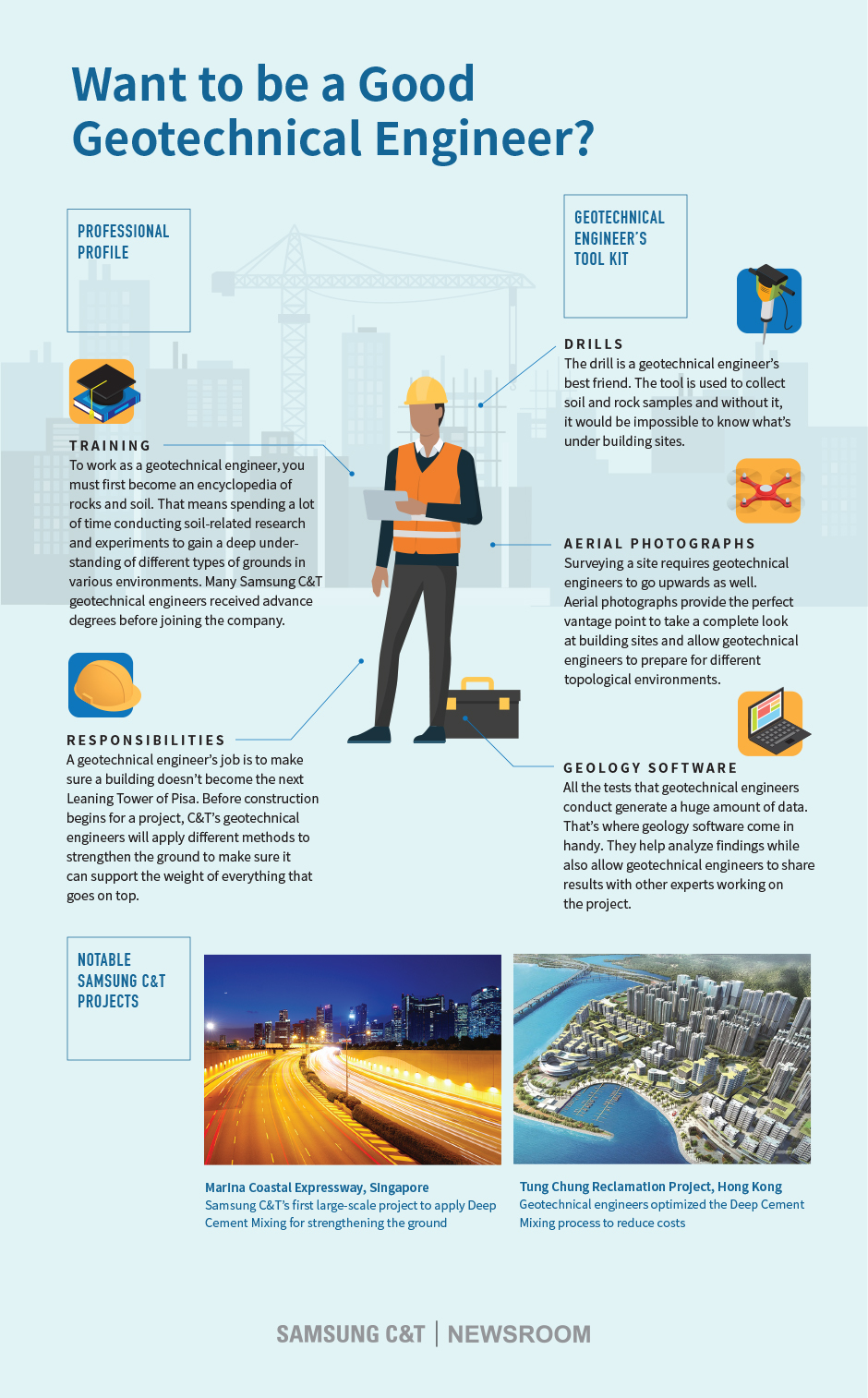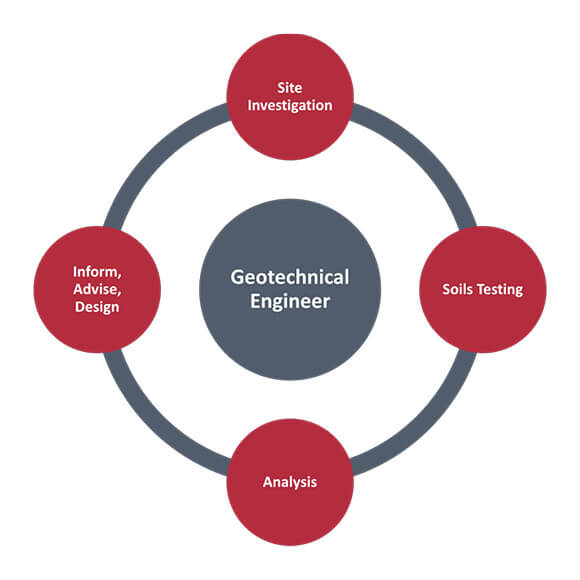The 45-Second Trick For Geotechnical Engineering For Construction Projects
The 45-Second Trick For Geotechnical Engineering For Construction Projects
Blog Article
3 Easy Facts About Geotechnical Engineering For Construction Projects Explained
Table of ContentsNot known Facts About Geotechnical Engineering For Construction ProjectsExcitement About Geotechnical Engineering For Construction ProjectsGeotechnical Engineering For Construction Projects Things To Know Before You Get ThisGeotechnical Engineering For Construction Projects Things To Know Before You BuyGeotechnical Engineering For Construction Projects Things To Know Before You Get ThisThe 25-Second Trick For Geotechnical Engineering For Construction ProjectsGeotechnical Engineering For Construction Projects for Beginners
and Kovacs, W. (1981 ), An Introduction to Geotechnical Design, Prentice-Hall, Inc. Deep Scan Technology (2023 ): Deep Scan Technology uncovers covert frameworks at the site of Denmark's tallest structure. "Geofrost Coring". GEOFROST. Retrieved 20 November 2020. Han, Jie (2015 ). Concepts and Practice of Ground Improvement. Wiley. ISBN 9781118421307. RAJU, V. R.Ground Improvement Technologies and Case Histories. Singapore: Research Posting Providers. p. 809. ISBN978-981-08-3124-0. Ground Improvement Principles And Applications In Asia. Pariseau, William G. (2011 ). Design analysis in rock technicians. CRC Press. Hegde, A.M. and Palsule P (Geotechnical Engineering for Construction Projects).S. (2020 ), Performance of Geosynthetics Reinforced Subgrade Subjected to Repetitive Lorry Plenties: Speculative and Numerical Studies.
Cengage Understanding, Stamford, 666 p. Atkinson, J., 2007. The auto mechanics of dirts and structures. Taylor & Francis, N.Y., 442 p. Drifting Offshore Wind Turbines: Reactions in a Sea state Pareto Optimum Styles and Financial Evaluation, P. Sclavounos et al., October 2007. Nicholson, D, Tse, C and Cent, C. (1999 ). The Observational Approach in ground engineering concepts and applications.
Not known Details About Geotechnical Engineering For Construction Projects
Laboratory and area testing plays a critical function in this process. By drawing out examples from the earth's subsurface and using a suite of examinations, geotechnical engineers can anticipate the practices of dirt layers and review their viability for different building and construction efforts. The significance of geotechnical design in civil design can not be overemphasized, attributable to numerous elements: The preliminary action in any type of geotechnical research includes determining the dirt kind at the building and construction website.
The foundation acts as the bedrock of any kind of building and construction project. Selecting the proper structure kind is a choice that hinges on the extensive analysis supplied by geotechnical design.

Geotechnical site investigation is a crucial action in the planning and implementation of any kind of building and construction task. It includes the collection and analysis of information associated with the physical properties of dirt and rock beneath a proposed construction site. This information is crucial for the design and building and construction of secure, steady, and lasting frameworks.
The Only Guide to Geotechnical Engineering For Construction Projects
, also recognized as subsurface expedition, entails a collection of activities intended at identifying the soil, rock, and groundwater conditions at a building and construction site. The main objectives are to determine potential geotechnical risks, evaluate the engineering buildings of subsurface products, and give suggestions for the style and construction of structures, retaining wall surfaces, and other structures.
The workdesk study assists in identifying possible geotechnical concerns and planning the succeeding fieldwork. This includes observing the topography, water drainage patterns, existing structures, plants, and any signs of instability or erosion.
Some Ideas on Geotechnical Engineering For Construction Projects You Need To Know
Superficial examination pits are dug deep into to directly observe and example the dirt and rock. This approach works for examining the upper layers of the subsurface and determining near-surface threats. Non-invasive geophysical approaches, such as seismic refraction, ground-penetrating radar (GPR), and electric resistivity tomography (ERT), are utilized to map subsurface conditions and find abnormalities.
Dirt and rock examples accumulated during the area investigation are subjected to laboratory screening to identify their physical and mechanical properties. These examinations supply important information for geotechnical evaluation and layout.
The primary benefit of geotechnical site investigation is making sure the security and security of structures. By recognizing the subsurface problems, designers can make structures and various other structural aspects that can endure the lots and ecological forces they will be subjected to. This decreases the threat of negotiation, decrease, and architectural failing.
How Geotechnical Engineering For Construction Projects can Save You Time, Stress, and Money.
Recognizing dirt qualities can direct the option of excavation methods, dewatering techniques, and ground enhancement measures. This ensures efficient and safe building practices. Geotechnical site investigations are frequently required by developing codes and guidelines. Following these demands makes certain compliance with lawful and safety and security standards, staying clear of possible lawful liabilities and job hold-ups.
This information is vital for task managers, engineers, and specialists in creating practical schedules, spending plans, and backup strategies. Geotechnical Engineering for Construction Projects. Skyscraper Building in a Coastal AreaIn a seaside city, a high-rise domestic structure was intended on a site with thought loosened sand down payments and a high water table. An in-depth geotechnical investigation, including borehole drilling, CPT, and geophysical studies, was carried out
Excitement About Geotechnical Engineering For Construction Projects
Based upon these searchings for, the foundation design was modified to consist of deep stack foundations expanding right into stable strata, and ground improvement techniques, such as vibro-compaction, were carried out to reduce liquefaction threats. This positive method made certain the safety and stability of the structure while avoiding costly post-construction removal. Facilities Growth on a Sloping TerrainA major facilities task, including the construction of a freeway and bridges, was intended on a sloping terrain with high inclines.

The Leaning Tower next page of Pisa (Italy), a legendary architectural marvel, is infamous for its unplanned tilt from substantial geotechnical problems. The tower's structure was inadequately made to deal with the soft, unsteady dirt underneath it, bring about uneven negotiation and its distinctive lean. Our globe is dotted with remarkable infrastructure projectsfrom looming high-rises to sprawling bridgesall standing testimony to the advancement of the various building tools and methods available.
Geotechnical engineering is a specific field within civil engineering that concentrates on researching the actions of planet products. This branch digs deep right into the groundinvestigating how the dirt, rock, and groundwater at a building and construction website can influenceand be affected bythe infrastructure that we put up on and right into them. Prior to a single brick is laid or a concrete structure put, geotechnical engineers probe right into the earthgathering vital information concerning the site's soil composition, rock structure, and groundwater levels.
Some Ideas on Geotechnical Engineering For Construction Projects You Need To Know

is a device used to assess the stability and load-bearing ability of heaps throughout installment, leveraging the look at this site principle of wave proliferation. It maximizes building and construction performance by offering real-time analyses, thus making certain safe and reliable stack foundations. Among the useful applications of geotechnical engineering entails determining and carrying out the right techniques for foundation construction.
Load driving represents greater than the mere act of putting architectural aspects into the ground. On the contrary, it is a very carefully managed process of moving a structure's tons past the much less secure soil layers more detailed to the surfacedown to the more considerable strata that exist under. In the case of stack driving, take into consideration exactly how geotechnical designers adeptly utilize this method to uniformly disperse the framework's weight.
Report this page